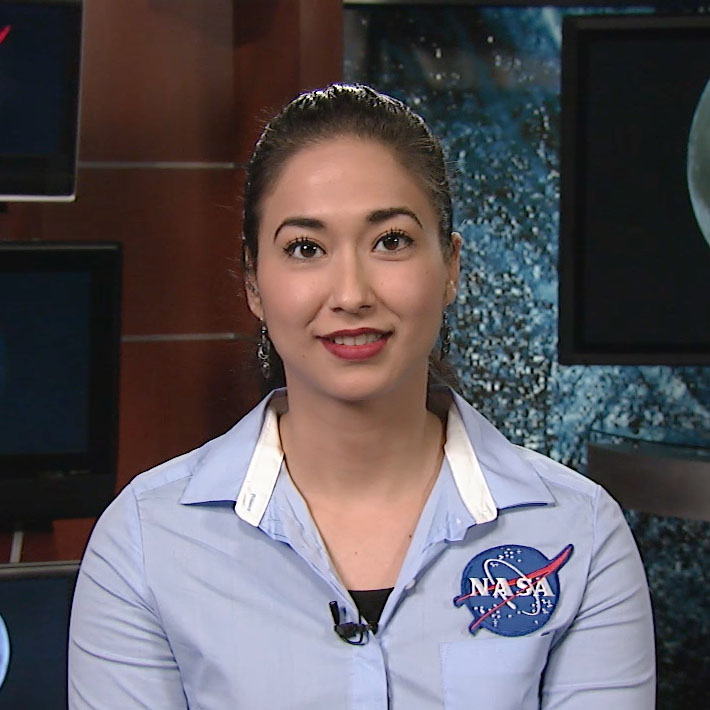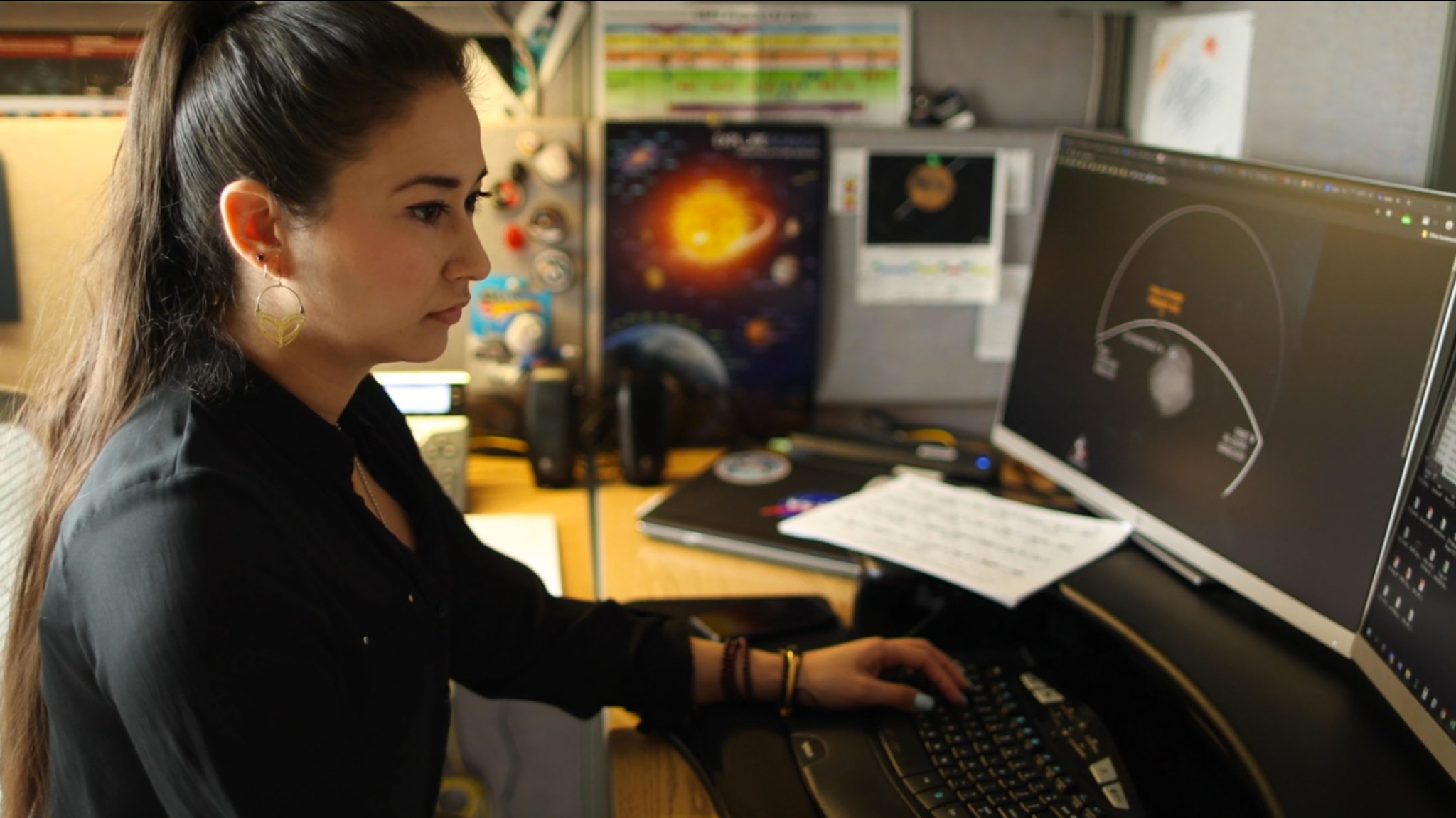Nayi Castro began working with NASA’s OSIRIS-REx mission in 2018 as the spacecraft approached asteroid Bennu. She started on the mission as deputy mission operations manager (“MOM” for short, in NASA-speak). Today she serves in the role of lead MOM. As OSIRIS-REx gets ready to leave Bennu, Castro shares her thoughts on her work with OSIRIS-REx (NASA’s first-ever asteroid sample return mission) and her career with NASA, as well as her personal interests.
What are the responsibilities of a MOM?
Nayi: I manage all of the activities associated with sending commands to, and receiving data back from, the spacecraft. This includes the communication and transfer of products amongst team members, based in Maryland, Arizona, Colorado, and California, something that became particularly challenging during COVID-19.
How are you feeling about OSIRIS-REx leaving Bennu?
Nayi: It’s bittersweet to say goodbye to the asteroid that was our spacecraft’s home since OSIRIS-REx’s arrival in 2018. There was a lot of innovative science and engineering tailored to the design and operation of OSIRIS-REx, by an incredible team. As the team starts to focus on return cruise and Earth reentry operations, I am excited to know that scientists will have a piece of Bennu to study and further deepen our understanding of our cosmic surroundings and of ourselves.
It will take OSIRIS-REx two years to cruise back to Earth. That’s a long road trip. What music do you like to listen to on long road trips?
Nayi: One of my long road trip playlists would shuffle around Fleetwood Mac, Converge, Florence + the Machine, Bright Eyes, Brandy, Cursive, Bruce Springsteen, Marc Anthony, Misfits, David Bowie, Ms. Lauryn Hill, Glassjaw, Hermanos Gutierrez, The Roots, Jewel, mewithoutYou, Louie Vega, Grupo Niche, Pixies, Ricardo Arjona, The Smiths, The Mountain Goats, The Clash, and on and on.
What was your favorite moment during the mission?
Nayi: With 2020 being such a difficult year for humankind, I was fortunate to be on a team that prioritized health, safety, and continued mission success. A favorite thing for me to observe was the progress made through each 2020 mission milestone, such as the Checkpoint Rehearsal, Matchpoint Rehearsal, and ultimately the Touch-and-Go (TAG) asteroid sample collection [Editor’s note: successfully completed in October]. It was inspiring to see a team’s dedication striving towards a shared objective, despite being further socially distanced and geographically separated than before.
How did you get to NASA? What training or jobs or interests led you to this position?
Nayi: As a child, I found the work at NASA centers fascinating. When my parents watched the news, if there happened to be a segment on a NASA mission, my ears would perk up because I thought it was incredible that we could learn about objects beyond our home planet. My uncle’s enthusiasm for space missions and the technology and science supporting them also greatly influenced me.
I pursued my curiosity of space via an astronautical engineering degree. While I was still in school, NASA and my undergraduate program initiated my career in spacecraft operations when they granted me the opportunity to certify as a flight controller on a NASA mission.
What is your favorite, most challenging, or most rewarding part of the work?
Nayi: My favorite part of this work is seeing the achievements that are a direct result of every team member’s hard work. It is inspiring to work among science and engineering experts who continuously explore and understand Earth and outer space. I am delighted that these discoveries can then be shared with everyone. It is rewarding to take a step back and appreciate the depth of knowledge that has been collected for decades.
Credits: NASA’s Goddard Space Flight Center; gameplay footage provided courtesy WNBA, used with permission
What missions have you worked on for NASA before OSIRIS-REx?
Nayi: I’ve been fortunate to work on two NASA Earth-observing missions and a lunar mission. I was a college intern when I worked on the Tropical Rainfall Measurement Mission (TRMM). At TRMM, I learned how to effectively communicate with the satellite and be mindful of good spacecraft health and safety strategies. After TRMM, the Terra mission was my first full-time opportunity. I was part of the flight team that supported 24/7 on-console operations. The next mission was the Lunar Reconnaissance Orbiter (LRO), where I spent most of my operations time. That was a great experience that provided me with various ways to expand my flight console expertise and systems engineering knowledge. I also work with the Mars Atmosphere and Volatile EvolutioN (MAVEN) spacecraft. This mission continues to provide an abundance of information on the Martian atmosphere.
What do you do in your free time – any hobbies or sports or outside interests?
Nayi: I enjoy reading, practicing yoga, listening to music, and spending time with loved ones. My dogs also bring me a lot of joy!
Anything else that you’d like people to know?
Nayi: I hope that people can find a theme of unity and progress in many of the missions that NASA has flown throughout the years. I aspire to support science and engineering to further understand our solar system and beyond and more of ourselves.
This video is public domain and along with other supporting visualizations can be downloaded from NASA Goddard’s Scientific Visualization Studio at: https://svs.gsfc.nasa.gov/13677
By Rani Gran
NASA’s Goddard Space Flight Center, Greenbelt, Md.
D






























